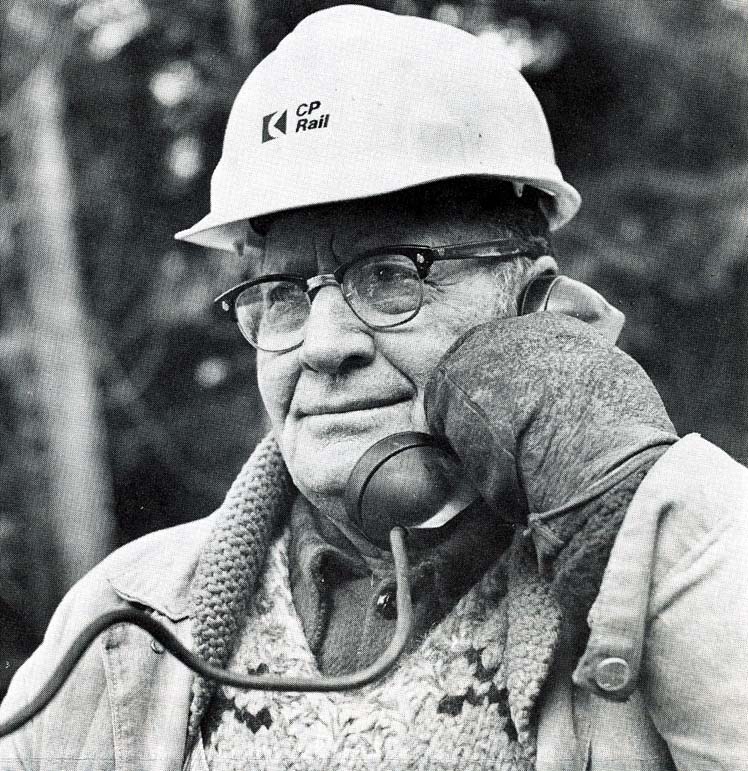
1982-1984
|
|
Volume 13
Number 4 March 9, 1983 |

|

The first thing railroader Vic Ficocelli would look at was their hands. The men, maybe 200 of them, were queued outside the door, a rag-tag group of expectant, nervous, and poor men hoping for a better chance in a country whose name most of them couldn't spell.
Some, Vic discovered many years later, thought he was a doctor, the way he studied their hands, the weathered skin on their faces, the breadth of their shoulders.
"I looked first for the callouses. A man with callouses on his hands is a working-class man," said Vic.
Most were fooled by Vic's shirt and tie and neatly pressed slacks. Only the village doctor could afford such attire on a work day. Vic should have shown the palms of his own hands. There would have been no mistaking the laborious work of the owner of such leathery, thick, skin.
RECRUITING POOR
Laying track with pick, hammer, and spike maul for 30 years will do that to a man's hands. So will the ropes from fishing nets and ox-driven farm plows. The difference, of course, was money.
North America was booming in the decade following the end of the Second World War. In Canada, the railways were straining to transport the country's natural resources. Improved trackbed and heavier rail were needed to accommodate the longer, heavier, trains.
The years following the war hadn't been as kind to Europe. Poverty underscored a lagging economy.
Seasoned railroaders like Vic were sent to Europe to recruit men willing to do the gruelling work of the section gangs which Canadians were refusing for better paying jobs in rejuvenated mills and factories.
Villagers would be lined up for hours before the doors opened. Those who qualified were moved into a second line. Even the rejected would wait expectantly, holding onto a shred of hope that something would change the padrone's mind.
"Some of them had big families five, six, seven, kids," recalled Vic. "They would cry like babies when they found out they had no chance. You had to be strong."
Those who came to Canada had to be strong, too. "When they came over, they left behind their families, sometimes for two or three years, until they could save enough money to get a place to live and to pay the way over for their families," he said.
Vic was no stranger to hard work when he came to Canada at 18 years of age in 1927. His family farmed in a village in the Campobaso province of Italy.
But instead of farm work, he joined a section gang at Fort Steele, B.C. The pay was 30 cents an hour, the work punishing, the conditions hard. He stayed for the next 47 years.
"The men, four or five of them, lived in bunkhouses placed every five miles (eight kilometres) along the track," he recalled. "The bunkhouses were usually one or two rooms, with a stove and a small wood heater. There were no buses to take the men from the bunkhouse to the job. We used pump cars. If you had a family, you went home on weekends."
There were days when each man was laying 20 ties by hand. "You had to take out the old ties, put in the new ones, and spike them. I'd get back to the bunkhouse and just lie on the bed, too tired to eat," he said.
Four years after joining CP Rail, Vic was promoted to relief section foreman on the Albert Canyon subdivision at a time when the railway was changing to heavier rail.
DONE BY HAND
"At that time, everything was done by hand," he said. "There were about 30 men to lift those 39 foot (12 metre) rails and they were lifting all day long.
"The heavy steel gangs were big, about 90 men, and experienced foremen were needed to take them. The less experienced men, like me, were put in charge of smaller gangs."
In 1934, Vic was made permanent section foreman at Illecillewaet. In 1950, he became assistant roadmaster between Revelstoke and Glacier. A year later, he was promoted to roadmaster at Brookmere on the Kettle Valley Railway.
In 1954, he was transferred to North Bend and the following year he was sent on a recruiting expedition to Bologna, Italy, and the Portugese Azores islands, hiring between 900 and 1,000 men in a hectic four-day operation.
Vic was transferred to Laggan subdivision in 1964, his first stint on track outside B.C., where he remained until retiring in 1974.
His retirement year was an eventful one. He was named to the federal government Honors list in December and the following spring received the Order of Canada for outstanding service in railway operations from former Governor-General Jules Leger.
RETIREMENT SHORT-LIVED
But Vic's retirement was short-lived. CP Rail was beginning an exhaustive track improvement program through the mountains and experienced workers were needed. "I've worked two or three months a year as a flagger pretty well every year since retiring," said Vic.
Even at 73, Vic could hold his own on the section. He recounts, with obvious pride, the day earlier last summer when a road construction tractor tore up some rail at Twin Butte, near Revelstoke.
A section gang was called, but Vic could see no point in holding up an approaching train until the gang arrived. He grabbed a spike maul and hammer from his truck, tore out the spikes, realigned the rail and spiked it, all before the train arrived.
When the section gang arrived, they found a rather pleased looking senior citizen.